sensor Peugeot 308 2016 User Guide
[x] Cancel search | Manufacturer: PEUGEOT, Model Year: 2016, Model line: 308, Model: Peugeot 308 2016Pages: 398, PDF Size: 9.38 MB
Page 115 of 398

113
308_en_Chap04_eclairage-et-visibilite_ed02-2015
temporarily keeping the dipped beam
h eadlamps on after the vehicle's ignition has
been switched off makes the driver's exit easier
when the light is poor.
Manual
guide-me-home lighting
Switching on
F With the ignition off, "flash" the headlamps
us ing the lighting stalk.
F
A fu
rther "headlamp flash" switches the
function off.
Switching off
the manual guide-me-home lighting switches
o ff automatically after a set time.
Automatic guide-me-home
lighting
When the automatic illumination of headlamps
function is activated, under low ambient
light the dipped beams headlamps come on
automatically when the ignition is switched off.
Activation or deactivation, as well
as the duration of the guide-me-
home lighting, is set in the " Driving
assistance " menu, then " Vehicle
settings " in the secondary page.
Exterior welcome
lighting
the remote switching on of the lighting makes
y our approach to the vehicle easier in poor
light. It is activated when the lighting control
is in the " AUTO" position and the level of light
detected by the sunshine sensor is low.
Switching on
F Press the open padlock on the
r emote control or one of the front
door handles with Keyless
ent
ry
and Starting.
Switching offthe exterior welcome lighting switches off
a utomatically after a set time, when the ignition
is switched on or on locking the vehicle.
Programmingthe activation, deactivation and
c hoice of welcome lighting duration
are done in the " Driving assistance "
menu then " Vehicle settings ".
the
dipped beam headlamps and sidelamps
come on; your vehicle is also unlocked.
4
Lighting and visibility
Page 119 of 398
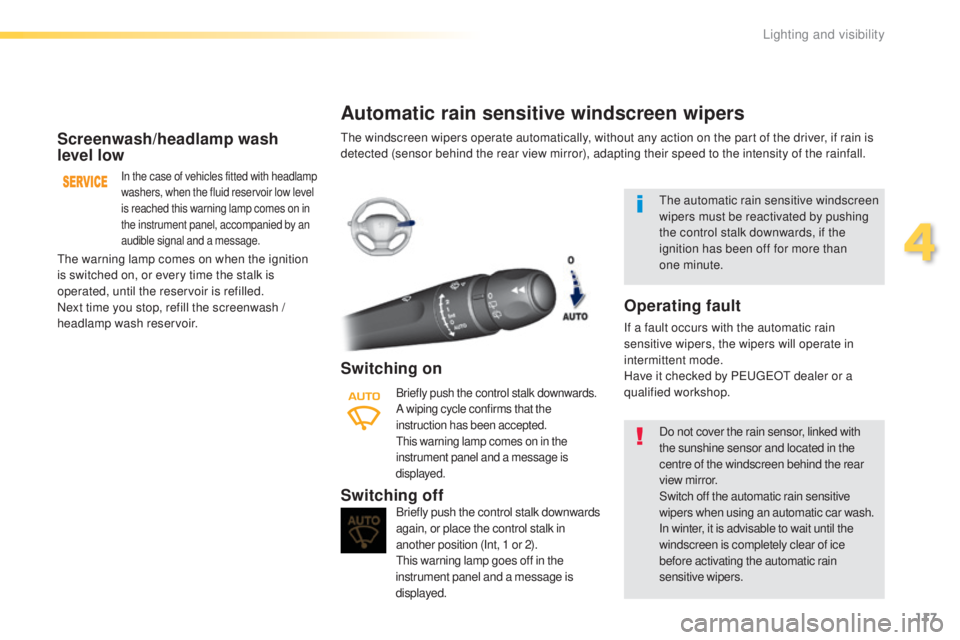
117
308_en_Chap04_eclairage-et-visibilite_ed02-2015
Screenwash/headlamp wash
level low
In the case of vehicles fitted with headlamp
washers, when the fluid reservoir low level
is reached this warning lamp comes on in
the instrument panel, accompanied by an
audible signal and a message.
Automatic rain sensitive windscreen wipers
Switching on
Briefly push the control stalk downwards.
A wiping cycle confirms that the
instruction has been accepted.
thi
s warning lamp comes on in the
instrument panel and a message is
displayed.
Briefly push the control stalk downwards
again, or place the control stalk in
another position (Int, 1 or 2).
thi
s warning lamp goes off in the
instrument panel and a message is
displayed.Switching off
the automatic rain sensitive windscreen
w ipers must be reactivated by pushing
the control stalk downwards, if the
ignition has been off for more than
one
m
inute.
the w
arning lamp comes on when the ignition
is switched on, or every time the stalk is
operated, until the reservoir is refilled.
Next time you stop, refill the screenwash /
headlamp wash reservoir.
the w
indscreen wipers operate automatically, without any action on the part of the driver, if rain is
detected (sensor behind the rear view mirror), adapting their speed to the intensity of the rainfall.
Do not cover the rain sensor, linked with
the sunshine sensor and located in the
centre of the windscreen behind the rear
view mirror.
Switch off the automatic rain sensitive
wipers when using an automatic car wash.
In winter, it is advisable to wait until the
windscreen is completely clear of ice
before activating the automatic rain
sensitive wipers.
Operating fault
If a fault occurs with the automatic rain
sensitive wipers, the wipers will operate in
intermittent mode.
Have it checked by P
eu
ge
Ot d
ealer or a
qualified workshop.
4
Lighting and visibility
Page 149 of 398

147
308_en_Chap06_conduite_ed02-2015
When towing
Distribution of loads
F Distribute the load in the trailer so that the
heaviest items are as close as possible to
the axle and the nose weight approaches
the maximum permitted without
exceeding
it
.
Air density decreases with altitude, thus
reducing engine performance. Above
1
0
00
m
etres, the maximum towed load must
be reduced by 10
% f
or every 1
0
00 metres of
altitude.
Side wind
F take into account the increased sensitivity
t o side wind.
Cooling
towing a trailer on a slope increases the
t emperature of the coolant.
As the fan is electrically controlled, its cooling
capacity is not dependent on the engine speed.
F
t
o lo
wer the engine speed, reduce your
speed.
the m
aximum towed load on a long incline
depends on the gradient and the ambient
temperature.
In all cases, keep a check on the coolant
temperature.
F
If t
he warning lamp and the
STOP warning lamp come on,
stop the vehicle and switch off
the engine as soon as possible.
Braking
towing a trailer increases the braking distance.to av oid overheating of the brakes, the use of
engine braking is recommended.
Ty r e s
F Check the tyre pressures of the towing
v ehicle and of the trailer, observing the
recommended pressures.
Lighting
F Check the electrical lighting and signalling
o n the trailer and the hadlamp beam height
of your vehicle.
For more information on adjusting the
headlamp beam height, refer to the
corresponding section.
For more information on weights (and
the towed loads which apply to your
vehicle) refer to the corresponding
section.
the r
ear parking sensors will be
deactivated automatically if a genuine
P
eu
ge
Ot t
owbar is used.
6
Driving
Page 190 of 398
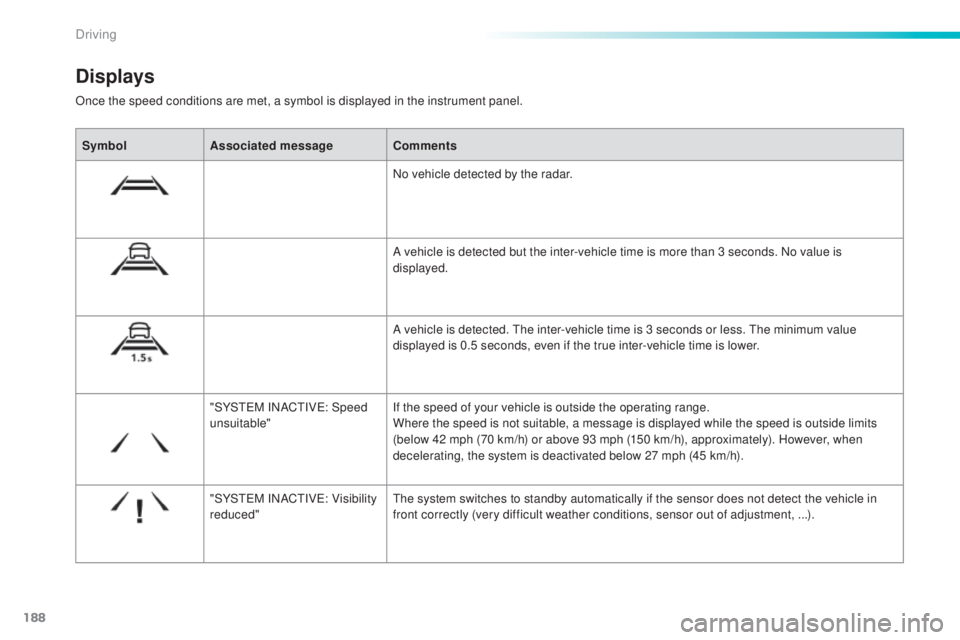
188
308_en_Chap06_conduite_ed02-2015
Once the speed conditions are met, a symbol is displayed in the instrument panel.
Displays
SymbolAssociated message Comments
No vehicle detected by the radar.
A vehicle is detected but the inter-vehicle time is more than 3 seconds. No value is
displayed.
A vehicle is detected.
the i
nter-vehicle time is 3 seconds or less.
the m
inimum value
displayed is 0.5 seconds, even if the true inter-vehicle time is lower.
"SYS
teM IN
AC
tIVe: Sp
eed
unsuitable" If the speed of your vehicle is outside the operating range.
Where the speed is not suitable, a message is displayed while the speed is outside limits
(below 42 mph (70 km/h) or above 93 mph (150 km/h), approximately). However, when
decelerating, the system is deactivated below 27 mph (45 km/h).
"SYS
teM IN
AC
tIVe: Vi
sibility
reduced"
the s
ystem switches to standby automatically if the sensor does not detect the vehicle in
front correctly (very difficult weather conditions, sensor out of adjustment, ...).
Driving
Page 191 of 398
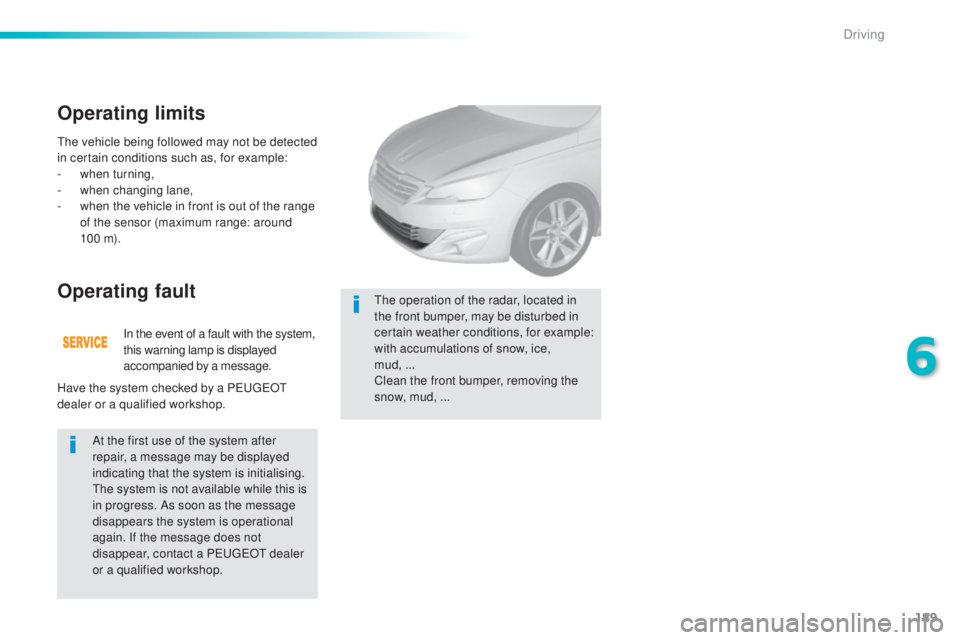
189
308_en_Chap06_conduite_ed02-2015
the vehicle being followed may not be detected
i n certain conditions such as, for example:
-
when
turning,
-
wh
en changing lane,
-
wh
en the vehicle in front is out of the range
of the sensor (maximum range: around
10 0
m)
.
Operating limits
In the event of a fault with the system,
this warning lamp is displayed
accompanied by a message.
Operating fault
Have the system checked by a Peu geOt
d ealer or a qualified workshop.
At the first use of the system after
repair, a message may be displayed
indicating that the system is initialising.
the s
ystem is not available while this is
in progress. As soon as the message
disappears the system is operational
again. If the message does not
disappear, contact a P
eu
ge
Ot d
ealer
or a qualified workshop.
the o
peration of the radar, located in
the front bumper, may be disturbed in
certain weather conditions, for example:
with accumulations of snow, ice,
mud,
...
C
lean the front bumper, removing the
snow, mud, ...
6
Driving
Page 197 of 398
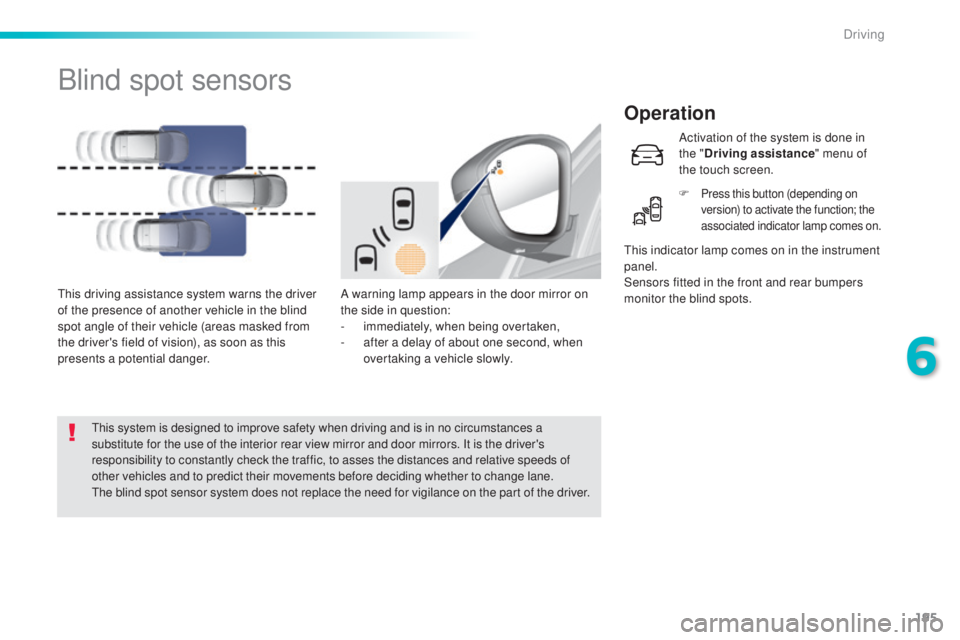
195
308_en_Chap06_conduite_ed02-2015
Blind spot sensors
Operation
A warning lamp appears in the door mirror on
the side in question:
-
im
mediately, when being overtaken,
-
af
ter a delay of about one second, when
overtaking a vehicle slowly.thi
s driving assistance system warns the driver
of the presence of another vehicle in the blind
spot angle of their vehicle (areas masked from
the driver's field of vision), as soon as this
presents a potential danger.
thi
s indicator lamp comes on in the instrument
panel.
Sensors fitted in the front and rear bumpers
monitor the blind spots.
thi
s system is designed to improve safety when driving and is in no circumstances a
substitute for the use of the interior rear view mirror and door mirrors. It is the driver's
responsibility to constantly check the traffic, to asses the distances and relative speeds of
other vehicles and to predict their movements before deciding whether to change lane.
the b
lind spot sensor system does not replace the need for vigilance on the part of the driver. Activation of the system is done in
the "
Driving assistance " menu of
the touch screen.
F
Press this button (depending on
version) to activate the function; the
associated indicator lamp comes on.
6
Driving
Page 199 of 398
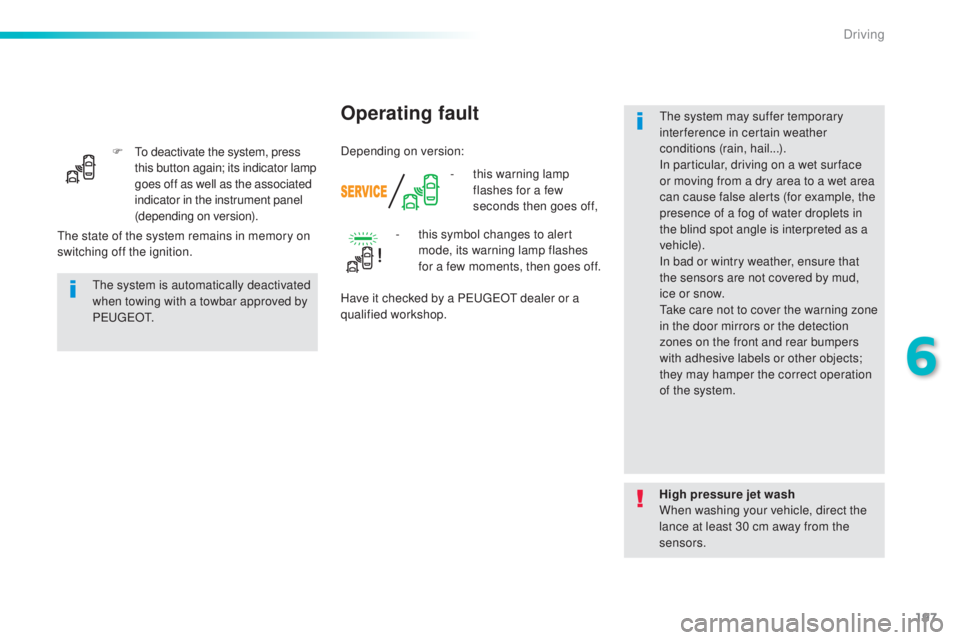
197
308_en_Chap06_conduite_ed02-2015
F to deactivate the system, press
t his button again; its indicator lamp
goes off as well as the associated
indicator in the instrument panel
(depending on version). -
th
is warning lamp
flashes for a few
seconds then goes off,
Operating fault
the system is automatically deactivated
w hen towing with a towbar approved by
P
e u
g e
Ot.
H
igh pressure jet wash
When washing your vehicle, direct the
lance at least 30 cm away from the
sensors.
the s
tate of the system remains in memory on
switching off the ignition. -
th
is symbol changes to alert
mode, its warning lamp flashes
for a few moments, then goes off.
Have it checked by a Peu geOt d ealer or a
qualified workshop.
the s
ystem may suffer temporary
interference in certain weather
conditions (rain, hail...).
In particular, driving on a wet sur face
or moving from a dry area to a wet area
can cause false alerts (for example, the
presence of a fog of water droplets in
the blind spot angle is interpreted as a
vehicle).
In bad or wintry weather, ensure that
the sensors are not covered by mud,
ice or snow.
tak
e care not to cover the warning zone
in the door mirrors or the detection
zones on the front and rear bumpers
with adhesive labels or other objects;
they may hamper the correct operation
of the system.
Depending on version:
6
Driving
Page 200 of 398
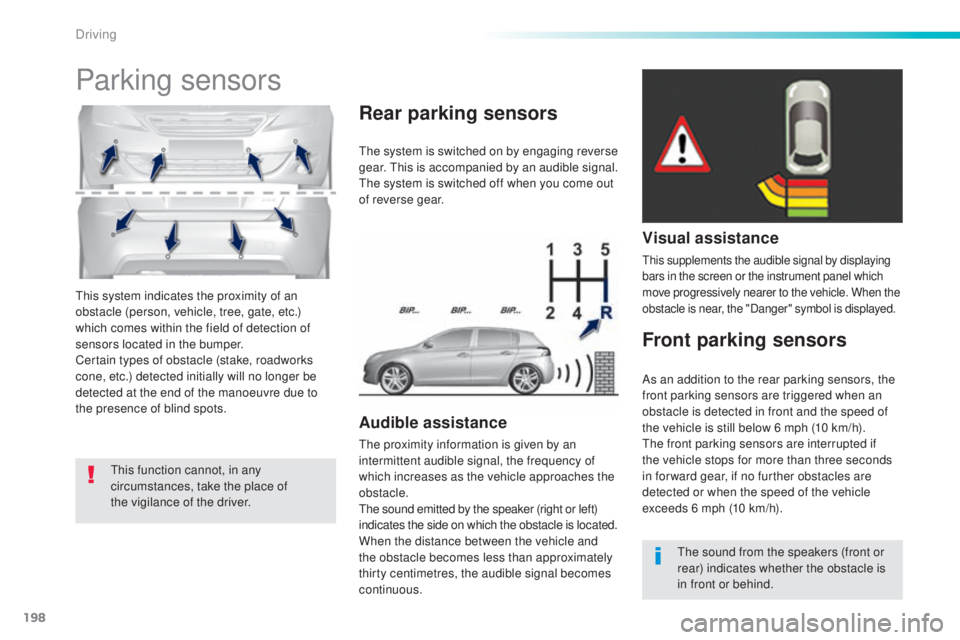
198
308_en_Chap06_conduite_ed02-2015
this system indicates the proximity of an
o bstacle (person, vehicle, tree, gate, etc.)
which comes within the field of detection of
sensors located in the bumper.
Certain types of obstacle (stake, roadworks
cone, etc.) detected initially will no longer be
detected at the end of the manoeuvre due to
the presence of blind spots.
Parking sensors
this function cannot, in any
c ircumstances, take the place of
the vigilance of the driver.
the s
ystem is switched on by engaging reverse
gear.
thi
s is accompanied by an audible signal.
the s
ystem is switched off when you come out
of reverse gear.
Audible assistance
the proximity information is given by an
i ntermittent audible signal, the frequency of
which increases as the vehicle approaches the
obstacle.
the s
ound emitted by the speaker (right or left)
indicates the side on which the obstacle is located.
When the distance between the vehicle and
the obstacle becomes less than approximately
thirty centimetres, the audible signal becomes
continuous.
Rear parking sensors
Visual assistance
this supplements the audible signal by displaying
b ars in the screen or the instrument panel which
move progressively nearer to the vehicle. When the
obstacle is near, the "Danger" symbol is displayed.
Front parking sensors
the sound from the speakers (front or
r ear) indicates whether the obstacle is
in front or behind.
As an addition to the rear parking sensors, the
front parking sensors are triggered when an
obstacle is detected in front and the speed of
the vehicle is still below 6 mph (10 km/h).
the f
ront parking sensors are interrupted if
the vehicle stops for more than three seconds
in for ward gear, if no further obstacles are
detected or when the speed of the vehicle
exceeds 6 mph (10 km/h).
Driving
Page 201 of 398

199
308_en_Chap06_conduite_ed02-2015
the system will be deactivated
a utomatically if a trailer is being
towed or a bicycle carrier is fitted on
a towbar (vehicle fitted with a towbar
installed in line with the manufacturer's
recommendations).
Deactivation / Activation of
the front and rear parking
sensors
the system is deactivated in the
" D
riving assistance " menu of the
touch screen.
F
Pr
ess this button.
the i
ndicator
lamp in the button comes on.
Pressing this button again reactivates the function.
the i
ndicator lamp in the button goes off.
the p
arking sensors are deactivated
while the Park Assist system is
measuring a space.
For more information on Park Assist,
refer to the corresponding section. High pressure jet wash
When washing your vehicle, do not
direct the lance within 30 cm of the
sensors.
Operating fault
- this warning lamp comes on in
t
he instrument panel and/or a
message appears, accompanied
by an audible signal,
-
this symbol changes to alert mode,
its warning lamp flashes for a few
moments then stays on and a
message appears, accompanied by
an audible signal.
Contact a Peu geOt d ealer or a qualified
workshop. In bad weather or in winter, ensure
that the sensors are not covered with
mud, ice or snow. When reverse gear is
engaged, an audible signal (long beep)
indicates that the sensors may be dirty.
Certain sound sources (motorcycle,
lorry, pneumatic drill, etc.) may trigger
the audible signals of the parking
sensor system.
Depending on version and when engaging
reverse:
6
Driving
Page 202 of 398

200
308_en_Chap06_conduite_ed02-2015
Reversing camera
Opening the tailgate causes the display
to disappear.
the
reversing camera is activated automatically
when reverse gear is engaged.
Depending on version, the image is displayed
in the touch screen or the instrument panel. High pressure jet washing
When washing your vehicle, do not
direct the lance within 30 cm of the
camera lens.
the s
uperimposed representation of guide
lines helps with the manoeuvre.
the
y are represented by lines marked "on
the ground" and do not allow the position of
the vehicle to be determined relative to tall
obstacles (for example: other vehicles, ...).
Some deformation of the image is normal.
the r
eversing camera cannot in any
circumstances be a substitute for
vigilance on the part of the driver.
the r
eversing camera function may be
completed with parking sensors.
the b
lue lines represent the general direction
of the vehicle (the difference corresponds to
the width of your vehicle without the mirrors).
the r
ed lines represent a distance of about
30 cm beyond the edge of your vehicle's rear
b u m p e r.
the g
reen lines represent distances of about
1
a
nd 2 metres beyond the edge of your
vehicle's rear bumper.
the t
urquoise blue curves represent the
maximum turning circle.
Clean the reversing camera regularly using a
soft, dry cloth.
Driving